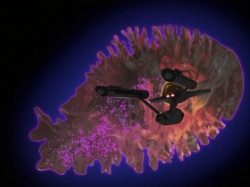Protoplasm
Protoplasm is the living contents of a cell that are surrounded by a plasma membrane. This term is not commonly used in modern cell biology. Protoplasm is composed of a mixture of small molecules such as ions, amino acids, monosaccharides and water, and macromolecules such as nucleic acids, proteins, lipids and polysaccharides. In eukaryotes the protoplasm surrounding the cell nucleus is known as the cytoplasm and that inside the nucleus as the nucleoplasm. In prokaryotes the material inside the plasma membrane is the bacterial cytoplasm, while in gram-negative bacteria the region outside the plasma membrane but inside the outer membrane is the periplasm.
Protoplasm is the living substance inside the cell, and is distinct from non-living cell components lumped under "ergastic substances" or inclusion bodies, although ergastic substances can occur in the protoplasm. In many plant cells most of the volume of the cell is not occupied by protoplasm, but by "tonoplast," a large water filled vacuole enclosed by a membrane. A protoplast is a plant or fungal cell that has had its cell wall removed.
History of the term[edit]
The word protoplasm comes from the Greek protos for first, and plasma for thing formed. It was first used in 1846 by Hugo von Mohl to describe the "tough, slimy, granular, semi-fluid" substance within plant cells, to distinguish this from the cell wall, cell nucleus and the cell sap within the vacuole. Thomas Huxley later referred to it as the "physical basis of life" and considered that the property of life resulted from the distribution of molecules within this substance. Its composition, however, was mysterious and there was much controversy over what sort of substance it was. Unsurprisingly, attempts to investigate the origin of life through the creation of synthetic "protoplasm" in the laboratory were not successful.
The idea that protoplasm is divisible into a ground substance called "cytoplasm" and a structural body called the cell nucleus reflects the more primitive knowledge of cell structure that preceded the development of electron microscopy, when it seemed that cytoplasm was a homogeneous fluid and the existence of most sub-cellular compartments, or how cells maintain their shape, was unknown. Today, it is known that the cell contents are structurally very complex and contain multiple organelles.
- In 2268 The USS Enterprise Under the command of Captain James T. Kirk encountered a Giant Space Amoeba. The same entity was responsible for consuming systems in the 39J sector of space and had also destroyed the Vulcan manned Constitution Class starship USS intrepid (NCC-1631)with all hands.
